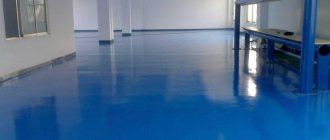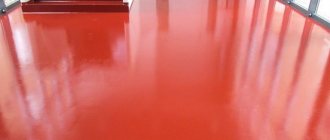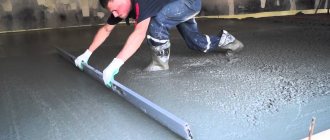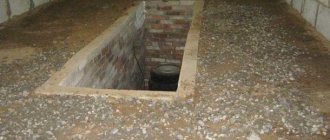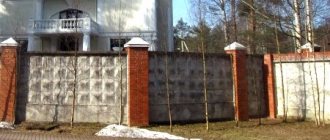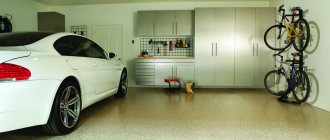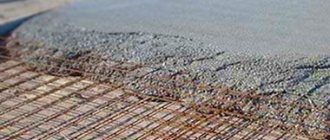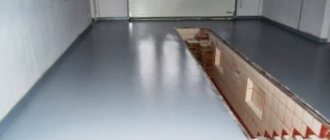After laying a concrete floor, very often the owners of the premises have a question - do they need to paint the floor? The floor definitely needs to be painted. In addition to ensuring an aesthetic issue, you will be able to minimize the risk of injury to the floor, which is out of the operational permit.
What can happen to a floor that is no longer in use:
- Injury due to a fall;
- Violation of the integrity of goods stored in a garage;
- Increasing the frequency of wet cleaning of equipment and machinery located in the garage;
- Ingestion of dust particles from the respiratory tract, and subsequent allergic reaction.
Pros and cons of concrete garage floors
Concrete flooring is by far one of the most common garage flooring options.
Pros:
- Economical option for garage flooring;
- Durable material;
- High strength;
- No tendency to corrosive processes;
- Protecting the premises from parasites;
- Harsh working conditions and high load.
You should also not forget about the disadvantages of concrete pavement.
Minuses:
- A high degree of porosity of the material, which will absorb all odors without additional topping;
- May be very dusty;
- If a concrete floor is laid incorrectly, there is a possibility of rapid manifestation of corrosion processes;
- The appearance of an unpleasant odor.
Experienced builders believe that covering a garage floor with concrete is the right choice, but in order to extend the life of the material, it is necessary to cover the concrete composition with another layer of topping or another material.
Concrete flooring is by far one of the most common garage flooring options.
The need for dust removal, and what to cover with
Additional protection of the concrete floor allows you to increase the strength of the material and significantly reduce the amount of dust generated. To do this, at the stage of garage construction, dry cement or a layer with polymer toppings is laid on top of the fresh mortar. If this procedure was neglected at the initial stage of pouring the floor, the floor is covered with:
- tree;
- ceramic tiles;
- rubber plates or PVC.
You can also polish the concrete or make a self-leveling floor. Each of the proposed options requires relatively high costs. The best way to remove dust from a garage is to apply paint to the floor.
Causes of dust and defects
Either gender will show damage sooner or later. They come in two types: mechanical and operational. Mechanical damage is the most common reason why concrete floors have to be dismantled or renewed.
Mechanical:
- Chips;
- Potholes;
- Blistering of material;
- Cracks;
- Peeling of the top layer of concrete pavement.
Why do mechanical coatings occur? Because during the calculation of the composition-water-sand ratio, errors were made that led to a decreased or increased density of the material. Chips and potholes appear due to active mechanical impact on the area most susceptible to damage. In addition to mechanical damage due to the use of flooring, sooner or later operational damage will appear.
Operational damage:
- Surface dusting;
- Peeling of individual zones;
- Cracking of the screed surface;
- Deformation processes on the screed surface.
Operational damage occurs for the same reason as mechanical damage - an incorrect “water-composition-sand” ratio. The difference is that during operational manifestations the most active impact is not exerted on the deformation zone.
There are also climatic damages that can cause a corrosive process:
- High humidity;
- Sudden temperature changes;
- High temperatures;
- Location in a maritime climate zone.
Chips and potholes appear due to active mechanical impact on the area most susceptible to damage.
Specifics of the surface to be painted
The floor of a concrete car box differs from any other coating in that it has increased requirements for its strength. This surface is subject to increased physical and chemical influences, which contribute to rapid wear.
For convenience, we have compiled a table of factors influencing the concrete surface, which will need to be taken into account when choosing paintwork materials (paint and varnish material).
| Operation factor | Coverage Requirements |
| Vehicle weight when parked | High strength |
| When braking, the load on the coating is increased several times. | Increased resistance to physical stress and abrasion |
| High humidity (especially in the off-season, water from the wheels and bottom drains onto the floor) | High humidity resistance |
| Exposure to chemically active substances (gasoline, oils, anti-corrosion compounds, road chemicals) | Chemical inertness |
| For unheated garages | Resistance to temperature changes, elasticity |
To summarize, we can say that the paint intended for the floor of such a room should be as durable as possible, resistant to wear, not susceptible to aggressive chemicals, easily tolerate temperature changes and not react to high humidity.
On a note! Having chosen the type of paint, you should also pay attention to the color of the future coating. Light shades will make the room visually larger, make it easier to find small fallen things, and contribute to uniform lighting of the space.
Selecting paint for the garage floor
Having figured out what requirements the garage flooring must meet, you can begin choosing the finishing material.
Garage paint can be on a different basis; let’s consider the most suitable compositions for this:
| Paint type | Benefits of coverage | Flaws |
| Alkyd-urethane |
| Average strength |
| Acrylic (latex) |
| High price |
| Polyurethane |
| Some difficulty in preparing for use of a two-component composition |
| Epoxy |
| Some difficulty in preparing for use of a two-component composition |
The first two types of paint are significantly inferior in strength characteristics to coatings based on polyurethane or epoxy compositions. Due to its absolute non-toxicity, acrylic paint is more suitable for interior finishing work in living rooms or for treating walls and ceilings, i.e. surfaces that do not experience heavy and constant physical stress.
These compounds have a higher price, so it is still better to give preference to polyurethane or epoxy.
The material polyurethane is known to everyone. It is used to make shoe soles, which means that such paint will undoubtedly be very durable in the garage.
Epoxy mixtures can even be used outdoors. Such compositions are used in automobiles and shipbuilding. The coating is absolutely not afraid of water, low temperatures, high physical activity and increased friction, and is inert to any chemicals.
Important! When choosing what to paint the floor surface in the garage with, you should choose materials based on insoluble resins. Alkyd, oil-based, and organofluorine paints should not be used. These coatings will most likely change color and structure upon contact with any type of fuel.
Why paint your garage floors?
The floor in the garage must be painted not only to improve the aesthetics of the coating, but also to increase the level of strength and durability of the concrete coating. Painting a floor does not guarantee 100% durability. Once a year, based on how often the floor is used and for what type of work, it will be time to reapply a coat of paint. It is necessary to choose paint with high resistance to abrasion during operation.
Popular paint compositions for concrete floors:
- Polyurethane;
- Epoxide;
- Acrylic;
- Impregnation;
- Liquid glass;
- Rubber compound.
The floor in the garage must be painted not only to improve the aesthetics of the coating, but also to increase the level of strength and durability of the concrete coating.
Specifics of coating, wear factors
Pros and cons of concrete floors
A concrete floor is durable, but without a protective coating it generates a lot of dust.
First, let’s look at all the advantages of the coating:
- Strength, wear resistance. That’s why they love to use it for flooring in factories, production and warehouse areas where daily mechanical loads are high;
- Durability - with proper filling and operation, the floor can last about 20-30 years without repair;
- Practicality - all the necessary components are cheap and available. And in order to eliminate various floor defects that have appeared during service, it is usually enough to fill it with a thin layer of cement-sand or concrete mixture;
- Hygiene and environmental safety: the material does not accumulate static electricity; when used correctly, the dense structure prevents deep penetration of microorganisms, bacteria and fungi; Natural and harmless materials are used in production.
Now let's talk about the disadvantages:
- The material has a porous structure, which is why when mechanical damage occurs to an unprotected surface, characteristic dust appears. The floor seems to be “peeling”, and gray dust settles on all objects in the room. Inhaling tiny particles of concrete can hardly be considered beneficial to human health. But in order to prevent the material from collecting dust, it is enough to cover it with a protective layer of paint;
- Unattractive appearance of the coating. Yes, a gray concrete floor can hardly be called beautiful. Although for a garage, warehouse or industrial premises this is hardly a serious drawback;
- Water permeability, sensitivity to chemical compounds in gasoline, oils, and auto chemicals. With constant exposure to moisture and aggressive chemicals, the coating can collapse literally in a matter of months. To avoid this, it is enough to take care of its protection in time;
- The appearance of cracks, chips, roughness, subsidence. Over time, any coating deteriorates. But if this happens ahead of schedule, it means that important rules of pouring or operation were violated: the laying technology was not followed, the features of the base were not taken into account, the load on the coating was too high. These nuances should be taken into account when pouring a concrete floor.
The main factors of material wear during operation in a garage
Before painting, the concrete floor is thoroughly dust-free and wet cleaned.
- Large load on the coating. The car leaves and enters the garage premises every day. Often this is where light repairs of the car and any work related to keeping it running are carried out;
- High humidity. The garage does not always have good heating and ventilation, so in the autumn-winter period the room can be quite humid. Water also gets onto the floor when raindrops run off the surface of the car or snow melts;
- Exposure to low temperatures. Often there is no heating at all in the garage or it is not good enough;
- Exposure to chemicals: gasoline, motor oils, anti-freeze, car shampoos and polishes, anti-corrosion liquids.
Important! The paint must be resistant to moisture, aggressive chemical compounds, temperature changes and mechanical abrasion.
What is required from a concrete screed
Before laying a concrete screed, it is worth considering some factors that may ultimately affect the final concrete surface.
Technical specifications:
- The minimum thickness of the screed depends on the class of composition used;
- It is inadmissible to refuse reinforcement if a high-intensity load on the floor is expected;
- Mandatory waterproofing if there is a possibility of a seasonal increase in humidity.
If the garage area is large, then it is necessary to develop a technological map that will display the location of reinforcement materials and waterproofing joints.
The minimum thickness of the screed depends on the class of the composition used.
Calculation of required materials
To calculate the required volume of concrete, you need to multiply the surface area of the garage by the height of the concrete pour. In order for a concrete coating to last a long time, its height must be at least 10 cm. When calculating the amount of concrete required, it is worth taking into account the need to create a supply of material of approximately 10-12%. To improve the quality characteristics of concrete, special additives are purchased for the mixture, which increase resistance to harmful substances and enhance the wear resistance of the coating. For example, for concrete grades from M300 to M550, you can purchase the “Elastoconcrete” additive, which increases adhesion.
Requirements for a concrete floor
The minimum thickness of the concrete floor screed must be no less than 20 mm and no more than 40 mm. In rooms where there is a possibility of sudden temperature changes and intense loads on the concrete surface, expansion joints are required.
Primary requirements:
- Leveling the surface of the base layer;
- Concealment of passing pipeline routes;
- Ensuring the thermal insulation condition of the room.
If the concrete screed is very old, and not only becomes dusty, but also cracks and even without any special impact, chips appear on it, it is necessary to completely dismantle it. Garage floor painting should only be done on a workable surface.
The minimum thickness of the concrete floor screed must be no less than 20 mm and no more than 40 mm.
Review of the best paints
We continue to talk about what paint to coat the concrete floor inside a motorhome. Which brand is the best?
On a concrete base, experienced specialists recommend using the following options:
- Teping P 1155 is an epoxy paint characterized by the highest level of abrasion resistance. It is used when the air humidity inside the building is no more than 90%, the temperature range is from 10 to 27 degrees Celsius. The optimal temperature for use is 22 degrees. The composition is able to withstand heavy loads - up to 220 kg/cm2;
- Temafloor is a two-component epoxy paint from the Tikkurila brand. Manufactured without solvents, it is suitable for painting new and old concrete floors, and can withstand temperatures up to +70 degrees. To create a dense, elastic paint film on the base, you will also need Temafloor Flex hardener;
- Polymerstone-1 is a polyurethane enamel that can be applied to the base at a humidity of up to 4% and a temperature of more than 5 degrees. It has high strength, practicality, and is used economically.
Conditions for painting the garage floor
First of all, the concrete coating must be perfectly dry.
Foundation requirements:
- Concrete composition class – not lower than M 400;
- Getting rid of dust and debris using a construction vacuum cleaner;
- Grouting existing cracks and chips;
- Repeated drying of the surface with a heat gun or construction fan;
- Strict adherence to painting instructions for a specific composition;
- The paint for the concrete floor in the garage must correspond to the intensity of use.
Drying the floor perfectly is a must. Neglecting it risks corrosion and swelling of the composition.
First of all, the concrete coating must be perfectly dry.
A little about the cost
Depending on the region and manufacturer, the cost of paint will vary. But to calculate costs, you can take the average price offered by online stores.
So, depending on the forming substance, the paint will cost:
| Paint type | Average cost in rubles per 1 kg |
| Alkyd-urethane | 500 |
| Acrylic (latex) | 200 |
| Epoxy | 400 |
| Polyurethane | 480 |
It is also necessary to take into account the consumption of 1 kg per 1 m2; this indicator must be written on the packaging.
Paints used for concrete floor
During the construction process, the question often arises: how to paint the concrete floor in the garage? Concrete paint for garage floors should be originally designed for this purpose.
How to paint a concrete floor cheaply? You may not like the answer, but nothing. If you want to save on the quality of the operating surface, then do not paint the floor at all.
Concrete paint for garage floors should be originally designed for this purpose.
Acrylic paint
This is the most versatile product for painting concrete floors in industrial garages. Acrylic paint for concrete in a garage should contain impurities that will increase production characteristics, allowing multi-ton exposure to equipment.
Painting a concrete floor in a garage with acrylic composition – advantages:
- No pungent odor;
- Moisture resistance;
- Larger selection of colors;
- Eco-friendly composition;
- Economical application consumption;
- Short drying time.
The acrylic composition dries very quickly. After 15 hours you can already move freely along it. Technical operation with multi-ton impacts is possible in 2-3 days.
Before deciding how many layers to apply, consider the thickness of the layer and the coverage of the application.
The acrylic composition dries very quickly.
Polyurethane compositions for concrete floors
How to paint a concrete floor in a garage? If you are not interested in the acrylic composition, then pay attention to polyurethane. The consistency of the paint will be thicker than that of acrylic, which means the hiding power will be higher.
The consistency of the paint will be thicker than that of acrylic, which means the hiding power will be higher.
Polyurethane mastics
This type can serve as a method of waterproofing floor coverings. You can choose the color scheme yourself, since polyurethane mastics can also be mixed. Due to the high degree of application density, this composition is able to hide small cracks and chips. Polyurethane composition is one of the most wear-resistant paints for concrete floors.
Drying takes at least 24 hours. You can’t even step on the composition if 24 hours have not passed.
This type can serve as a method of waterproofing floor coverings.
Polyurethane paints
The main difference from mastics is that they are applied in a thin layer. Layer – 1 mm. The paint should be applied to a perfectly cleaned and dried surface. If there are small chips, then it is necessary to carry out work to grout the surface. Drying takes about 24 hours.
The paint should be applied to a perfectly cleaned and dried surface.
Epoxy compounds
How to paint the floor in the garage and the area in front of the garage? Epoxy paint. This composition for painting concrete garage floors is not afraid of ultraviolet rays, high temperatures and high humidity.
The epoxy mixture must be applied in 2 layers. Each individual layer must dry within 24 hours.
But epoxy paint for concrete floors has one drawback - the complexity of the work. If you have not encountered this composition before, then it is better to find specialists who will correctly apply the epoxy composition. The fact is that it hardens very quickly. If you work with the composition very slowly, there is a high probability that unevenness will appear.
This composition for painting concrete garage floors is not afraid of ultraviolet rays, high temperatures and high humidity.
Liquid glass
The basis of the material is a silicate layer. Increases the strength of concrete screed. Not afraid of moisture and mechanical stress. The liquid glass mixture will be very thick, so if it is difficult to work with, dilute it with water. The instructions for the composition will indicate how to dilute the paint.
Increases the strength of concrete screed.
Rubber paint
The rubber compound forms a protective film on the top layer of the coating. Rubber paint for concrete garage floors is non-toxic. Refers to fire-resistant compounds that are not afraid of high temperatures and fires. This composition dries very quickly. An hour after application, you can safely step on it.
Refers to fire-resistant compounds that are not afraid of high temperatures and fires.
Latex acrylic paints
The composition includes special polymers and acrylic resins. Such two-component products are popular due to their advantages:
- have toxic and chemical safety, so they are suitable for indoor work;
- quick drying and complete setting;
- ease of application to the surface;
- moisture resistance;
- resistance to direct sunlight;
- strength;
- the ability to choose colors, and they are bright and saturated, and do not fade quickly.
In addition to these advantages, you need to consider that acrylic paints are expensive. Another disadvantage is that the compositions do not tolerate low temperatures well. The third drawback is that they are difficult to remove from the surface later if repairs are planned in the future.
Polyurethane enamel
Polyurethane is used in shoe repair. It is used to make durable soles and heel caps that can withstand long-term friction on asphalt and other surfaces. Therefore, paint on a similar basis has also become popular as a floor option.
It is wear-resistant and durable. In addition, the advantages of such impregnation include the following:
- Beautiful appearance. The surface will be glossy, but not too slippery.
- Strength and resistance to various chemical compounds.
But you also need to take into account the disadvantages. The main one is the long period of complete drying. For the paint to dry completely and become durable, you need to wait 2 weeks. In addition, this composition is quite expensive, so many people prefer to choose cheaper options.
Epoxy paints
Such paints can be used not only for interior decoration of rooms, but also for exterior finishing of concrete surfaces. This is due to the fact that such material can withstand sudden changes in temperature and bad weather conditions. The surface after painting with these compounds becomes the most durable.
The paint is not susceptible to radiation, withstands constant friction and exposure to aggressive chemicals. The advantages include bright, rich shades. Moreover, the color will not fade. Adhesion to concrete surfaces is also good.
As for the disadvantages, they highlight the possibility of the formation of small cracks, as well as a small range of shades. It is recommended to do 2 layers of paint. The second one is applied after the first one has dried, which takes about 13 hours.
Alkyd-urethane enamels
This option for a concrete floor in a garage is also interesting. After painting, a beautiful glossy surface is obtained.
The product is suitable for interior work. The surface does not wear out and remains beautiful and shiny for a long time. But you need to keep in mind that this material is not the most durable. It is not highly resistant to various influences, so this coating is used less frequently than other types of paint.
You can apply enamel to a concrete floor using various tools, including spraying it from a professional spray bottle. The service life of the product is about 15 years.
Rubber paint
This paint dries quickly compared to other options - just 25 minutes is enough for 1 layer. The service life is about 10 years.
The composition is suitable for different temperatures. It can even withstand a decrease to -50°C and an increase to 60°C. After painting and drying, a durable polymer coating is obtained.
The layer is durable and can withstand various frequent loads. The coating protects the floor well from the formation of chips and screeds. If you add pigments to the composition, you get beautiful colors.
Anti-dust primers
Primers are used to prepare surfaces before painting, although some are used as a replacement for paint when it is necessary to prevent dust from forming on a concrete floor. Examples are epoxy and polyurethane. Primers are used when painting is not required.
The polyurethane variety fills the pores and small chips of concrete, making the surface as durable as possible. You can apply this product with a roller or brush - whichever is more convenient for you.
The mass has a high level of adhesion to the concrete base. It will protect the floor from the negative impacts that are typical for a garage. The layer dries quickly.
As for epoxy primer, it also has its own characteristics. After its application, a dense film is formed on the surface, which carefully closes all pores. No moisture passes through it. After drying, the surface will shine. Thanks to this treatment, the concrete floor becomes more durable, wear-resistant, and can withstand friction and other impacts.
Primers for concrete floors
For concrete floors, we recommend using epoxy and polyurethane based primers. They will level the surface layer. Using a primer, you can not only reduce the time of working with the coating, but also save paint, since you do not need to apply an extra sealing layer.
For concrete floors, we recommend using epoxy and polyurethane based primers.
The need for preliminary work
Before painting the concrete floor, it is coated with a primer. This operation allows you to strengthen the surface layer of concrete, fills all large pores and microcracks, and forms a composite with dust. Primer, a more common name for a substance, allows you to create an intermediate coating that:
- firstly, it will allow you to save finishing material, which will not be used to fill voids;
- secondly, it will provide the possibility of additional adhesion of the coloring matter to the base.
Painting a concrete floor with polymer coatings using appropriate primers will create a composite surface with high functionality.
How much paint will you need
To calculate the amount of paint we need to know:
- Garage area;
- Condition of garage flooring. The less roughness, chips and cracks, the less paint you will need;
- The number of layers of paint required.
The less roughness, chips and cracks, the less paint you will need.
Application and features of interaction with various materials
Despite the name that is indicated on the container for the roof, for metal, for concrete, all these types of paint have practically the same properties, the only difference is that roof paint has more active pigments, and concrete paint has more antifreeze and acrylatex , and metal paint contains more coalescent.
Exceptions are expensive paints of the best quality, as their warranty period is from 25 to 30 years, since it is considered truly resistant to wear. Such a definition as for external use is also not a complete enough description of the intended purpose of the paint, because its practical use is much wider.
It turns out that any rubber paint with a shelf life of 10 years or more is intended for a whole range of works, and among them we highlight:
- Basement and facade work, this also includes work with concrete, brick, gypsum, cement, plastered (without the use of slaked lime) putty surfaces.
- Painting roofs and other objects that are faced with clay and metal tiles, asbestos-cement slate, corrugated sheets, galvanized iron, ondulin, and tin.
- Indoor work on painting putty and plastered walls, plasterboard, non-woven, vinyl and other non-paper based wallpaper, chipboard and fiberboard.
- Used to reduce slipping to cover ramps, pools, and inclined surfaces.
Important! For painting surfaces that are constantly exposed to mechanical stress - running tracks, courts, playgrounds, pedestrian crossings, etc., it is better to use special paints with an extended shelf life - from 20 to 30 years.
The water resistance of rubber paint has made it an almost indispensable material for arranging a home pool.
- Application on wood surfaces that are constantly exposed to aggressive light and temperature, such as canopies and benches exposed to the sun. For interior work, it can only be used for painting the bathroom and toilet room.
- After preparation, it is possible to paint surfaces that were previously coated with alkyd or oil paints.
Helpful advice! The prohibition on using the emulsion as a coloring product for furniture and floors is a recommendation from the manufacturer, but experience shows that after proper preparation, the coating begins to withstand application to the floorboards of an outdoor gazebo. Based on this, the use of environmentally friendly and non-toxic paint for the purposes described above is a personal matter for each owner of a private home.
Recommendations:
- It is not recommended to use paint on breathable surfaces - furniture, interior floors, walls, as hydrophobic additives will prevent the exchange of air and the release of condensate formed.
- Do not use on surfaces that have a layer of slaked lime whitewash on them, as the latex paint base will simply roll off the lime.
- The paint has a reduced level of hiding power, and therefore should be applied in 2-3 layers.
Now it's worth considering how to prepare for painting a concrete floor with rubber paint.
Paint application stages
Before starting painting work, read the instructions on the packaging.
Stages of work:
- Pouring a small amount of paint from a paint tray.
- Impregnate the roller with paint and squeeze out the excess so that the layer is even.
- We begin the work process from the farthest corner of the garage.
If the paint dries quickly, we try to work quickly and calmly so as not to encounter any unevenness.
If the paint dries quickly, we try to work quickly and calmly so as not to encounter any unevenness.
Carrying out work
In every article devoted to the finishing coating of concrete surfaces, it will be written: untreated concrete generates dust. Therefore, painting the floor necessarily involves removing dust from the surface.
Depending on the type of paint used, this procedure is performed immediately at the time of painting or before applying paintwork.
Stages of work
You can paint the floor of the car box yourself with a minimum set of tools. Instructions for applying the composition to the surface are always printed by manufacturers on the packaging.
The following types of work will be common to all types of paints:
- We prepare the screed. At this stage, all defects, cracks, and irregularities should be removed. If necessary, you should update the screed by adding a leveling layer.
- We clean the leveled surface from debris, dirt and dust.
- We prime the base using a roller or brush, not sparing the primer material, generously.
- Give the primer time to dry (the indicator is written on the manufacturer’s packaging).
Important! Be sure to ensure that the primer composition works well with the type of paint. It is better to use materials on the same basis. Carefully read the instructions on the paint packaging: some compositions, usually epoxy paints, do not require prior priming of the surface.
- We prepare the paint composition according to the manufacturer's instructions. For two-component compositions, it is important to follow the order of infusion: the hardener is added to the compound in a thin stream, stirring constantly. Observe the proportions carefully.
- With the finished composition, paint the perimeter with a brush near the walls at a distance of up to 10 cm, as shown in the photo below. Then use a roller to apply paint over the rest of the area. Painting should start from the far corner towards the exit. It is better to apply paint in 2 layers. The second is applied after the first has completely dried.
Tips for painting a concrete garage floor
Rules and recommendations for coloring are described above. If the paint takes a long time to dry, there may be two reasons:
- High room humidity;
- Broken technology for applying the composition.
A powerful construction fan will help with this.
Painting your garage floor is a must.
Painting your garage floor is a must. Daily mechanical stress can turn a concrete floor into a mountain of dust. The concrete surface will generate dust in any case. The correct technology for laying the concrete screed will only affect how dusty the surface will be.
Coloring rules
Painting a concrete screed with your own hands is carried out in several stages. Before proceeding directly to applying the paint and varnish material, it is recommended to clean the surface to be treated of debris and dirt.
Due to the fact that concrete has a porous structure, dust accumulates inside the floor, due to which the surface will not be painted well enough. Small particles can be removed using moisture. Shortly before applying paint or enamel, wash the concrete floor and wait until it dries.
It is also recommended to check the humidity level indoors before processing. To do this, just stick a small piece of polyethylene on the floor and wait a day. If condensation occurs, the floor covering should be treated with epoxy paints.
Enamels are allowed to be applied no earlier than 90 days after pouring concrete. The screed must gain strength before processing.
Primer
Impregnation of concrete with a primer is a mandatory step, after which the strength of the screed increases and the pores close. This material increases the degree of adhesion of paints (enamel) and the floor in the garage.
Paint application stages
Before applying paint or enamel, it is recommended to read the instructions on the package. Each composition contains different compounds, as a result of which it imposes its own requirements on the condition of the floor covering. A number of enamels are allowed to be applied to a wet surface, others - exclusively to a dry one.
Staining is carried out during the following stages:
- The paint is poured into the tray.
- The roller is soaked in paint and wrung out. This can ensure uniform application of the composition to the concrete screed. If you do not squeeze it out, protruding stripes will appear on the surface being treated.
- Coloring begins from the far corner. It is recommended to apply the composition in squares, moving along the walls towards the exit from the garage.
When using quick-drying compounds, the entire floor surface must be painted at once. Otherwise the coating will be uneven.
Depending on the manufacturer's requirements, paints and enamels are applied in 1 or 2 layers. In the second case, you should wait until the composition has completely dried, and then begin re-processing the concrete.
The car is allowed to be driven into the garage after 12-24 hours. The time period is also determined by the manufacturer of the paint or enamel.
Temperature
Different compositions have their own requirements for future processing areas. Polyurethane paints are allowed to be applied to concrete at temperatures ranging from 0-17 degrees. The humidity level should not exceed 70%.
Epoxy primers can be used at temperatures from +5 degrees. Acrylic paints should be applied at +18 degrees and above. Rubber has good resistance to environmental influences. Therefore, such compositions can be used at temperatures from -50 to +60 degrees. The main thing in this case is to avoid rapid hardening of the material.
When working with other compositions, you should follow the requirements of the instructions.
